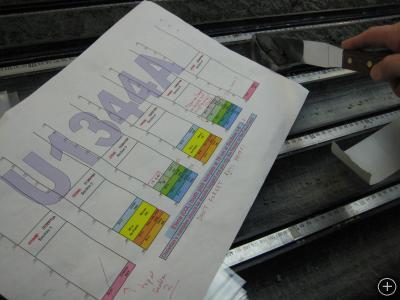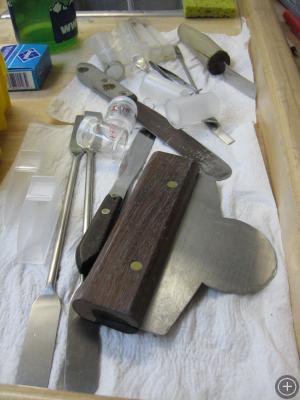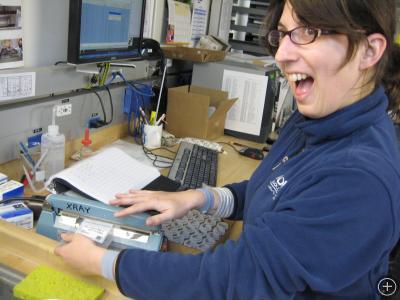Sampling
ABOARD THE JOIDES RESOLUTION, ON THE BERING SEA– Cores come in 24 hours a day, 7 days a week when we are at a drilling site. They are processed round the clock by the technicians, and then the scientists begin the process of whole round testing. After they’ve had a chance to warm up to room temperature we split them into halves. One half is imaged, described and archived. The other half is the working half. What happens to it? In this blog I’ll try to describe the story of the working half.
After being cut, the halves are split up. The working half is placed in marked trays that are labeled 1-7 and CC for the core catcher. They are identical to the trays on the description table, but these are where the scientists get their hands dirty and really go to work. Each site (and each hole for that matter) is different. Depending on the areas of interest for the scientists or possible information we might find at a particular site and depth various requests are made. It is the job of the Staff Scientist to assemble all of those requests with the input of the sampling committee which includes the Staff Scientist, the Co-Chiefs and the Curator. The finished product is the sampling plan.
Posted near the sampling table, this plan is the blue print for what the scientists take from the working halves. Samples range from toothpick scrapes, plugs, wedges, scrapes to mini cores. Microbiologists often take whole round samples (these are taken on the catwalk before the properties have a chance to change). In hard rock they can take what are called slabs. Drop stones can be taken directly out of the working half.
The samples are sealed in various containers and some are kept in freezers or cold rooms to keep any chemical changes from occurring. Some of the samples are tested or studied on board, but many are sent to the scientists at their home labs.
After the samples are taken, the spots disturbed by sampling are marked with either foam inserts or plastic dividers marked for the science they are used for (ex: PAL for Paleo, PP for Physical Properties). The remaining core material is packaged and labeled in special “D” tubes just like the archive halves in case more detailed sampling is requested post cruise. The “D” tubes are packed into boxes to eventually be shipped to College Station where they are hermetically sealed and eventually stored by the shore based curators.
Here is a quick clip of me sampling with David Scholl, one of the physical properties scientists in Expedition 323:
Hopefully that gives you some insight into the sampling on board the JR. Soon I’ll show you some specific sampling and testing that is done with the core material.

 No comments
No comments 








